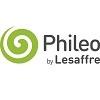
Content sponsored by:
Phileo by Lesaffre
Actisaf supports rising milk yields
Published: April 19, 2018
Source : Phileo Lessafre

Peaks Farm is located in the village of Onneley, just inside the Cheshire border and overlooking the surrounding counties of Staffordshire and Shropshire. Andrew Moss is the second generation of his family to run Peak Farm, after his Dad bought it 45 years ago, starting off with just 15 cows.
Today, the farm has transformed and is home to a high-yielding herd of 311 Holstein cows that currently average 10,100 litres/cow, with butterfat at 4.15%, protein 3.23% and a rolling cell count of 92. Milk is supplied to Muller on a Tesco aligned contract. The farm rears its own replacements, with the whole herd calving yearround. Until recently the farm was under TB restrictions, making year-round calving Andrew’s only option. With limited space, block calving would be difficult to manage without being able to move youngstock off the farm.
Andrew started working with Philip Jackson from HJ Lea Oakes in Autumn 2017, and in the short time they have been working together, Andrew has seen some pleasing improvements to herd heath and performance.
We have grown cow numbers in recent years and built a new shed three years ago, and a new parlour last summer,” explains Andrew. “Prior to working with Phil, yields were between 26-27 litres per cow per day, but we felt we could be doing a bit better. We feed our cows well, some may even say too well, but I believe if you want healthy cows that milk well and get back in calf quickly, you must feed well, and ultimately the feed will pay you back with these benefits.”
Last October changes were made to the diet and cows were moved onto HJ Lea Oakes Summit Gold 19 Nuts, which contain Actisaf live yeast, and are fed to yield through the parlour.
The rest of the ration consists of 30kg of home-grown grass silage, 12kg of maize silage, 5.5kg of a bespoke HJ Lea Oakes blend, which also contain Actisaf live yeast, and 1kg sugar liquid. The average feed rate of Actisaf live yeast is 6g per head per day, through both the parlour and feed barrier.
“I recommended the inclusion of Actisaf live yeast via the parlour nuts to help stabilise the rumen and ensure it could cope with the high intakes,” explains HJ Lea Oakes adviser, Philip. “The change from last year’s to this year’s maize silage also seemed to be causing issues with cell count, so we added the Actisaf to try to stabilise everything.”
“Working together with Andrew, we also made some changes to how the cows are grouped and there is now a separate transition group that are out of the main herd for two to three weeks following calving, and this change seems to be working well.” Andrew also has a dry cow group and splits his high and low yielding cows.
“The addition of Actisaf worked well, and we agreed to also include it in the blend after Christmas,” explains Philip. “Fertility on the farm is good, with a calving index of 398 days, and with the new diet the cows seemed to have more energy, look well, dung consistency has improved, the cows are content and Andrew is able to serve cows sooner.”
“We’re pleased with how the cows look and how they are performing since adding the Actisaf and making the other changes,” adds Andrew. “In total since adding it to the diet, yields have risen by as much as four litres per cow to between 28-30 litres per day at 170 days in milk.”
“Our next focus is turn out,” says Andrew. “We’ll turn the lows out in mid-April followed by the highs and we’ll continue to buffer feed the highs throughout the summer. I’m confident that the inclusion of Actisaf yeast in our spring feeds will help keep butterfat under control and act as a safety net when the diet changes and rumen is pushed that bit harder.”
Source
Phileo LessafreRelated topics:
Recommend
Comment
Share
Recommend
Reply
Recommend
Reply
15 de mayo de 2018
In Kenya its difficult to tell the brand name Actisaf since the traders and dealers never disclose what they are selling nor the source. What would be the better method of introducing thus maximizing the effect of the live yeast- soak in the concentrates such as dairy meal or soak during the silage preparations.
Recommend
Reply
15 de mayo de 2018
Good and valuable article. I would appreciate greatly receiving some more information about the current nutrition programme, hygienic procedures and the characteristics, variants and price of Actisaf. Thank you .Dr.Khazel (MSc, Diploma, Ph.D.).
Recommend
Reply
Recommend
Reply

Would you like to discuss another topic? Create a new post to engage with experts in the community.





